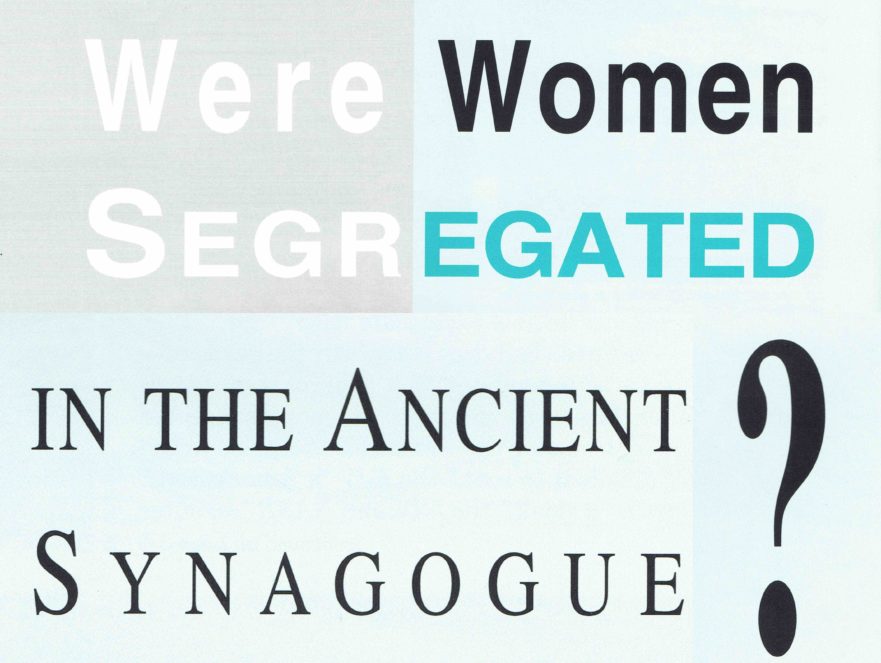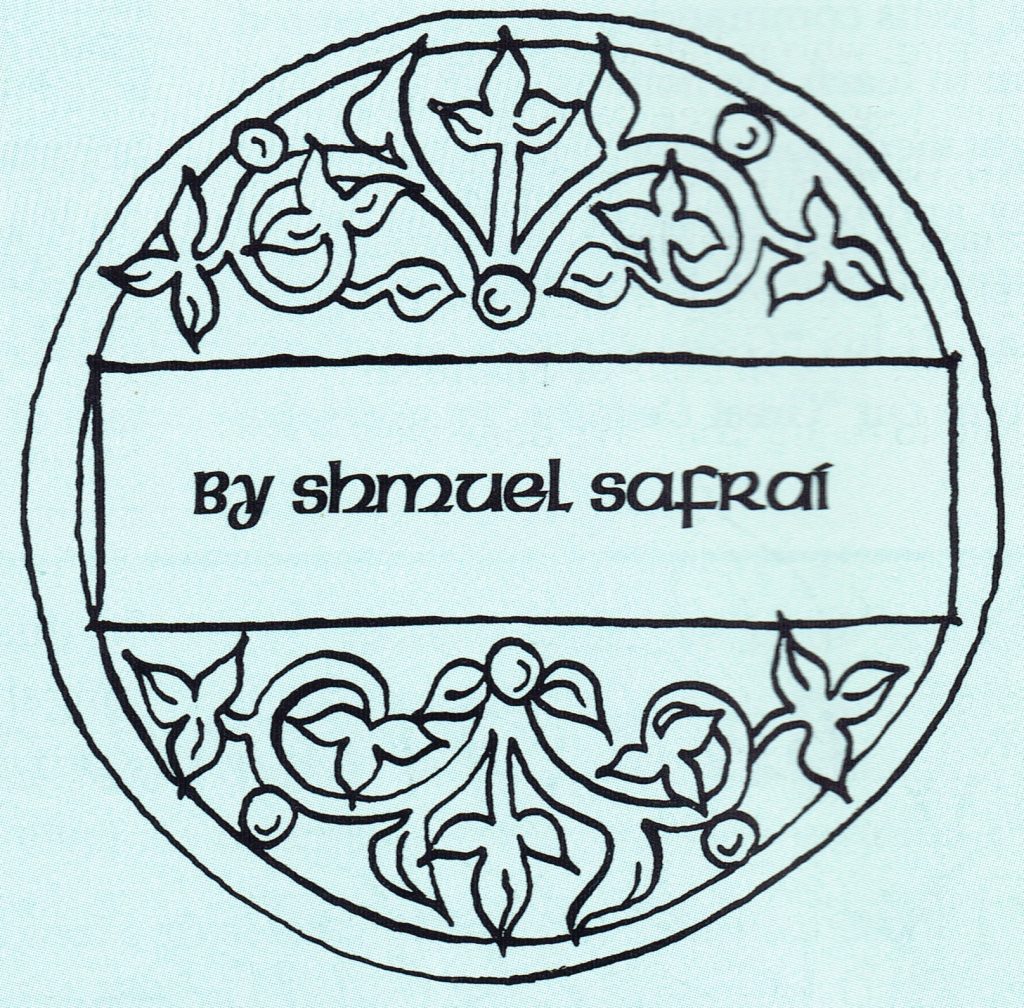When discussing the form and character of the synagogue, one should consider data from the land of Israel along with data from the Diaspora; there is no justification for treating them separately. The sources we will consider here pertain to synagogues in Jerusalem before the destruction of the Second Temple, throughout the land of Israel during the period of the Mishnah and Talmud, and in the Jewish Diaspora in Egypt, Syria and Greece.
The sources reveal that women regularly attended the synagogue and took part in its services, listening to sermons and to the reading of the Torah. Women also studied in the bet midrash (study hall).
A Woman’s Obligation
Prayer was a religious obligation not just of men, but also of women:
Women, slaves and minors are exempt from recitation of the Shema and from putting on phylacteries, but are not exempt from praying [the Eighteen Benedictions], affixing a mezuzah [to the doorpost of their house], or saying the blessing after meals.[66]
Women, like men, were obligated to pray the “Eighteen Benedictions” prayer daily. Rabban Gamaliel said: “One must say the ‘Eighteen’ every day.”[67] Although it was usual to pray the Eighteen Benedictions in an assembly of the congregation, women—and men—were permitted to pray them privately.
Premium Members and Friends of JP must be signed in to view this content.
If you are not a Premium Member or Friend, please consider registering. Prices start at $5/month if paid annually, with other options for monthly and quarterly and more: Sign Up For Premium

- [1] See Shmuel Safrai, “The Place of Women in First-century Synagogues,” Jerusalem Perspective 40 (Sept./Oct. 1993): 3. ↩
- [2] A baraita found in the Babylonian Talmud, Avodah Zarah 38b-39a. ↩
- [3] Jerusalem Talmud, Berachot 9d (end of chpt. 5); cf. Babylonian Talmud, Sotah 38b. ↩
- [4] Tractate Soferim 18:6. ↩
- [5] Tractate Soferim, end of chpt. 18. ↩
- [6] Yalkut Shim’oni, Ekev, remez 871 (Midrash Yelamdenu, an early rabbinic collection, is cited as the source); Yalkut Mishle 943; Sefer ha-Likutim V, 131a (ed. L. Greenhut, 1901). See Buber’s introduction to Midrash Proverbs, p. 32. ↩
- [7] Babylonian Talmud, Sotah 22a. ↩
- [8] Jerusalem Talmud, Sotah 16d (chpt. 1); Leviticus Rabbah 9:9; Numbers Rabbah 9:20; Deuteronomy Rabbah 5:15. ↩
- [9] Midrash ha-Gadol on Numbers (ed. Fisch, p. 122) adds taman (there). ↩
- [10] Literally, “go to hear his voice.” The Midrash ha-Gadol adds darish, i.e., “go to hear his voice preaching.” ↩
- [11] Evidently, women were not present in the study halls in Babylonia as they were in the land of Israel and in the Hellenistic Diaspora. See Babylonian Talmud, Moed Katan 18a. ↩
- [12] Mishnah, Demai 2:3. ↩
- [13] Ch. M. Horowitz, Niddah (Frankfurt, 1890), 30-33. ↩
- [14] Ibid., 48. ↩
- [15] This baraita seems severe, but many strict halachot no doubt had their origins in ancient traditions, traces of which have survived in tannaic literature. See Saul Lieberman’s comments on Sefer Metivot pertaining to purification after childbirth in B. M. Lewin’s edition (1934), 115ff. ↩
- [16] Achelis-Flemming, Die Syrische Didascalia (1908), 141; Harnack-Golhardt, Texte und Untersuchungen 25 (1904). Cf. Arthur Marmorstein, “Spuren Karäischen Einfluses in der gaonäischen Halacha,” Schwartz Festschrift (Vienna, 1917), 460; idem, “Judaism and Christianity,” Hebrew Union College Annual 10 (1935): 230. ↩
- [17] Only the Gaon Zemah forbade menstruating women from entering the synagogue. Cf. Otsar ha-Geonim, Berachot, pp. 48-49. ↩
- [18] Sefer Kol Bo, “Laws of the Niddah.” ↩
- [19] Jerusalem Talmud, Sotah 16c (chpt. 1). ↩
- [20] Leopold Loew, “Der Synagogale Ritus,” Monatschrift für Geschichte und Wissenschaft des Judentums 33 (1884): 364-374; later republished in Gesammelte Schriften, ed. Immanuel Loew (1898), 4:55-71. ↩
- [21] Babylonian Talmud, Kiddushin 81a. ↩
- [22] See Emil Schürer, Geschichte des jüdischen Volkes im Zeitalter Jesu Christi II4 (1901-1911), 527; cf. revised English version of Schürer’s work, The History of the Jewish People in the Age of Jesus Christ (175 B.C.-A.D. 135), ed. Geza Vermes, Fergus Millar and Matthew Black (Edinburgh: T. & T. Clark, 1979), 2:447-448, note 98; Jean Juster, Les Juifs dans l’Empire romain (1914), 1:458; Samuel Krauss, Synagogale Altertümer (1922), 357; idem, The History of Synagogues in Israel (1955), 339; Solomon Schechter, Studies in Judaism (1920), 1:313-326; E. L. Sukenik, Ancient Synagogues in Palestine and Greece (1934), 48; but cf. I. L. Elbogen, Der jüdische Gottesdienst (1931), 466-469. ↩
- [23] The festivities of the Water Drawing Celebration took place every night of the Feast of Sukkot excluding Sabbath and festival day itself, six nights if the first day of Sukkot fell on a Sabbath, five nights if it did not (Mishnah, Sukkah 5:1). ↩
- [24] Tosefta, Sukkah 4:1; Jerusalem Talmud, Sukkah 55b (chpt. 5); Babylonian Talmud, Sukkah 51b. ↩
- [25] Tosefta, Kelim Bava Kamma 1:12; Sifre Numbers, Naso 1; to 5:2 (ed. Horovitz, p. 4); Babylonian Talmud, Zevahim 116b; Numbers Rabbah 7:8. ↩
- [26] Cf. Shmuel Safrai, “The Role of Women in the Temple,” Jerusalem Perspective 21 (Jul./Aug. 1989): 5-6. ↩
- [27] Mishnah, Kelim 1:6-9: “There are ten levels of sanctity: the land of Israel is holier than any other land…the walled cities [of the land of Israel] are even holier…[the area] within the walls [of Jerusalem] is even holier…the Temple Mount is even holier…the rampart [which surrounds the wall of the three inner courts] is even holier…the Women’s Court is even holier…the Israelites’ Court is even holier…the Priests’ Court is even holier…the area between the porch and the altar is even holier…the sanctuary is even holier…the Holy of Holy is even holier.” ↩
- [28] Mishnah, Kelim 1:8. ↩
- [29] Babylonian Talmud, Pesahim 92b; Yevamot 7b; Zevahim 32b; cf. Jerusalem Talmud, Eruvin 22c (chpt. 5). ↩
- [30] Cf. Adolf Büchler, “The Fore-court of Women and the Brass Gate in the Temple of Jerusalem,” Jewish Quarterly Review 10 (1898): 667-718. Büchler suggests that the Women’s Court was created only in the last days of the Second Temple, but his arguments are unconvincing. Nevertheless, he is surely right in asserting that the Women’s Court was not one of the most ancient parts of the Temple. ↩
- [31] The anonymous sage who is quoted by Rabbi Joseph Ashkenazi (16th cent. C.E.) was right: “I have not found a text that says the Israelites’ Court is holier than the Women’s Court because women do not enter it. One may conclude, therefore, that women were not prohibited [from entering the Israelites’ Court]” (Melechet Shlomoh on Mishnah, Kelim 1:8). ↩
- [32] Tosefta, Arachin 2:1. ↩
- [33] Mishnah, Bikkurim 1:5; 3:6. ↩
- [34] Cf. Tosafot on Kiddushin 52b, to the paragraph, “Ve-chi ishah ba-’azarah, minayin?” ↩
- [35] Antiquities 15:419; War 5:199, 227. ↩
- [36] Büchler erred in accepting Josephus’ description. Cf. Büchler, op. cit., 697, note 1. ↩
- [37] Antiquities 15:418. ↩
- [38] Mishnah, Middot 2:5-6. ↩
- [39] Mishnah, Yoma 7:1; Babylonian Talmud, Yoma 69b. ↩
- [40] Mishnah, Sotah 7:8; Babylonian Talmud, Sotah 41b. ↩
- [41] Mishnah, Sukkah 5:1-4. ↩
- [42] Mishnah, Middot 2:5. ↩
- [43] Mishnah, Sukkah 5:2. ↩
- [44] Jerusalem Talmud, Sukkah 55b (chpt. 5); Babylonian Talmud, Sukkah 51b; Tosefta, Sukkah 4:1. ↩
- [45] Cf. Rashi’s commentary on this passage (Sukkah 51b), and Ch. Albeck’s commentary on the Mishnah (Sukkah 5:2). ↩
- [46] Jerusalem Talmud, Sukkah 55b (chpt. 5); Babylonian Talmud, Sukkah 51b. ↩
- [47] Jerusalem Talmud, Sukkah 55b (chpt. 5). ↩
- [48] Meir Ish Shalom was the first to make this suggestion (see Bet Talmud 4:200; cf. Sukenik, loc. cit.). ↩
- [49] Lamentations Rabbah, chpt. 1 (ed. Buber, p. 83); chpt. 4 (ed. Buber, p. 152). ↩
- [50] Ed. D. Kassel, p. 181. ↩
- [51] Based on Eusebius’ Praeparatio Evangelica 12:8. The source of this misunderstanding is apparently Juster (Les Juifs dans l’Empire romain, 1:458), from whom it has been copied by several other scholars. ↩
- [52] The Special Laws 3:171 (cf. Against Flaccus 89). See I. Heinemann, Philons griechische und jüdische Bildung (1932, repr. 1962), 234, and F. H. Colson’s note to 7:640 in the Loeb Classical Library edition of Philo. Philo also discusses matters pertaining to synagogues in his work Every Good Man Is Free, but without mentioning a women’s gallery. ↩
- [53] The Contemplative Life 69, 32. ↩
- [54] Cf. H. Kohl and C. Watzinger, Antike Synagogen in Galilaea (1916, repr. 1973), 35, plate II; Sukenik, loc. cit.; Sukenik, The Ancient Synagogue of Beth Alpha (Jerusalem, 1932), 15. ↩
- [55] Cf., for example, Jerusalem Talmud, Berachot 5d (end of chpt. 2); Shabbat 3a (chpt. 2); Babylonian Talmud, Hullin 92a. ↩
- [56] Cf. Carl H. Kraeling, The Excavations at Dura-Europos: The Synagogue (New Haven: Yale University Press, 1956), 8:16, 23. ↩
- [57] Ibid., plan VIII and p. 31. ↩
- [58] This inscription was published several times. See J.-B. Frey, Corpus Inscriptionum Iudaicarum (1952), inscription 1404, 2:332-335. Cf. also Moshe Schwabe, Sefer Yerushalaim (1956), 1:362-365 (Hebrew). ↩
- [59] Frey, Corpus Inscriptionum Iudaicarum (1936), inscription 694, 1:504-507. See Frey for a list of articles that discuss this inscription. ↩
- [60] Frey, inscription 781, 2:38-39. See Frey for a list of articles that discuss this inscription. ↩
- [61] Michael Rostovtzeff, Dura-Europos and its Art (1938), 100-134; John Winter Crowfoot, Early Churches in Palestine (1941), 1-8. ↩
- [62] Chrysostom, Orations against the Jews (Adversus Judaeos) I, 2. ↩
- [63] Cf. Tosefta, Megillah, chpt. 3; Tractate Soferim; Mishneh Torah, Tefillah, chpt. 11. ↩
- [64] Bet ha-Midrash (1855), 3:75. ↩
- [65] See footnote 25. ↩
- [66] Mishnah, Berachot 3:3. Women were also obligated to listen to the reading of the scroll of Esther at Purim (Babylonian Talmud, Megillah 4a; Arachin 3a). ↩
- [67] Mishnah, Berachot 4:3. ↩



![Shmuel Safrai [1919-2003]](https://www.jerusalemperspective.com/wp-content/uploads/userphoto/20.jpg)

Comments 1
Thank you for such careful scholarship.